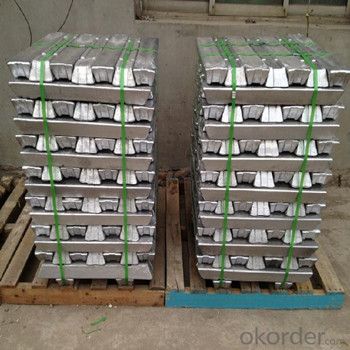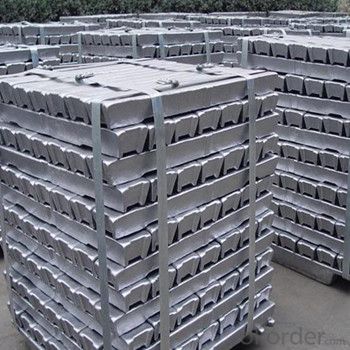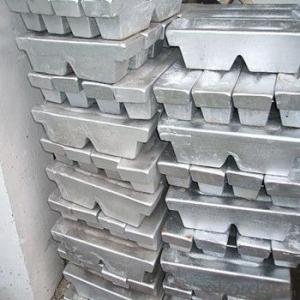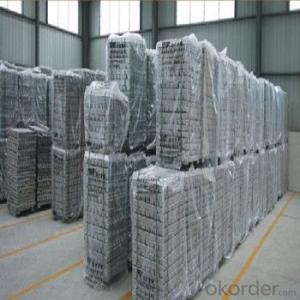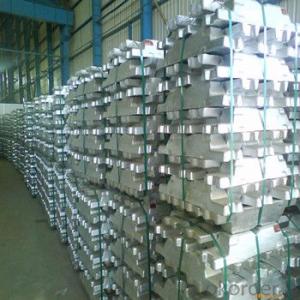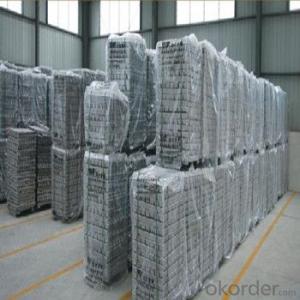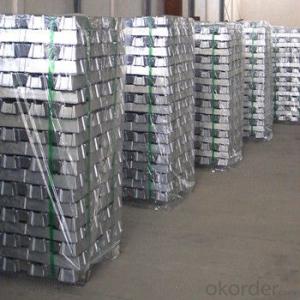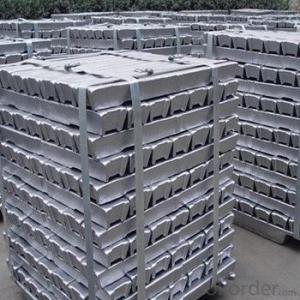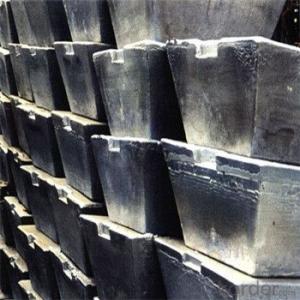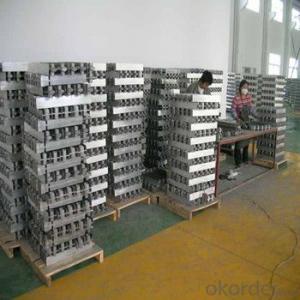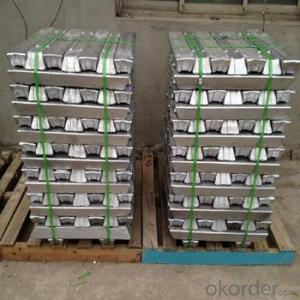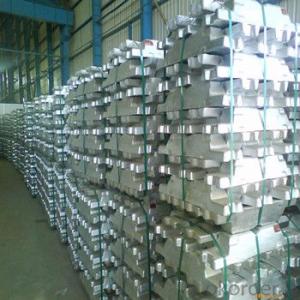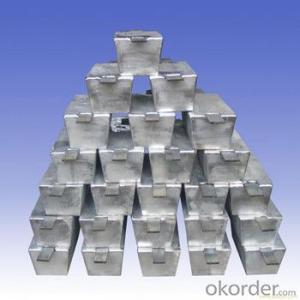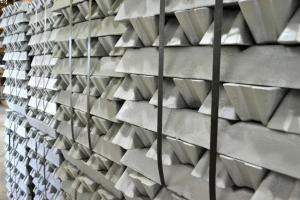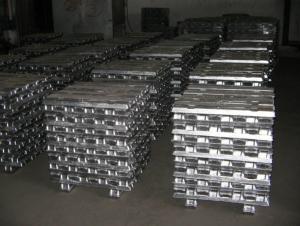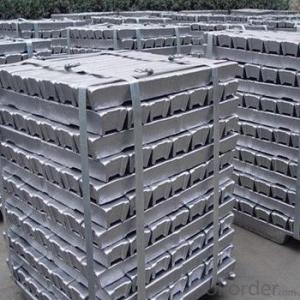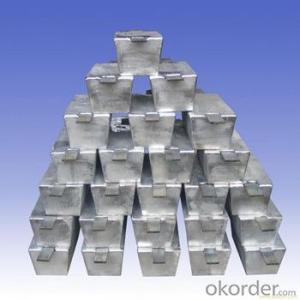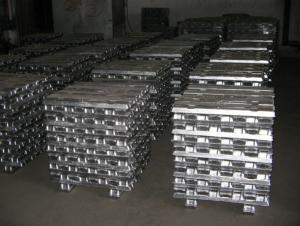Aluminum Pig/Ingot With High Purity And Best Price
- Loading Port:
- China main port
- Payment Terms:
- TT OR LC
- Min Order Qty:
- 1000 m.t.
- Supply Capability:
- 100000 m.t./month
OKorder Service Pledge
OKorder Financial Service
You Might Also Like
Pure Aluminum Pig/Ingot Used for Industry
1.Structure of Aluminum Pig/Ingot
A material that has been cast into a shape in order to be transported and processed easier than in an unprocessed form. An ingot is typically rectangular in shape, which allows it to be stacked. Ingots are most commonly associated with metals, with ingots of gold held in the vaults of banks and brokerages being popular images.
Aluminum Ingot is with the AL as the main chemical composition.Aluminum Ingot is used for industry,such as automobile,pinning and weaving,electron broadly and so on. Aluminum Ingot has the following advantages: easy control and operation, fast melting.
2.Main Features of the Aluminum Pig/Ingot
•High Purity
•Easy control and operation
•High strength
•Fast melting
•Competitive price
•Best Service
3.Aluminum Pig/Ingot Images
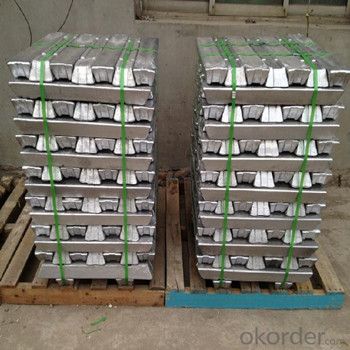
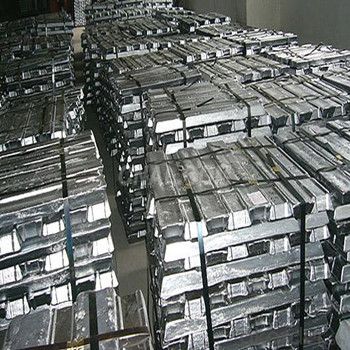
4.Aluminum Pig/Ingot Specification
Grade | Chemical Composition % | |||||||||
Al≥ | impurities ≤ | |||||||||
Si | Fe | Cu | Ga | Mg | Zn | Mn | others | Sum | ||
Al99.9 | 99.90 | 0.50 | 0.07 | 0.005 | 0.02 | 0.01 | 0.025 | - | 0.010 | 0.10 |
Al99.85 | 99.85 | 0.80 | 0.12 | 0.005 | 0.03 | 0.02 | 0.030 | - | 0.015 | 0.15 |
Al99.7 | 99.70 | 0.10 | 0.20 | 0.010 | 0.03 | 0.02 | 0.030 | - | 0.030 | 0.30 |
Al99.6 | 99.60 | 0.16 | 0.25 | 0.010 | 0.03 | 0.03 | 0.030 | - | 0.030 | 0.40 |
Al99.5 | 99.50 | 0.22 | 0.30 | 0.020 | 0.03 | 0.05 | 0.050 | - | 0.030 | 0.50 |
Al99.00 | 99.00 | 0.42 | 0.50 | 0.020 | 0.03 | 0.05 | 0.050 | - | 0.050 | 1.00 |
5.FAQ of Aluminum Pig/Ingot
We have organized several common questions for our clients,may help you sincerely:
①How about your company?
A big and famous and professional manufacturer & supplier of Aluminum Pig/Ingot, is one of the one of the large-scale professional investment Aluminum Pig/Ingot production bases in China.It have focuses on producing the Aluminum Pig/Ingot production for many years and gotten rich experience.Annually lagrge amount of Aluminum Pig/Ingot production are exported to markets in Europe,America and Japan. The quality and service have also gotten OEM service is available according to customer’s requirements.
②How to guarantee the quality of the products?
We have established the international advanced quality management system,every link from raw material to final product we have strict quality test;We resolutely put an end to unqualified products flowing into the market. At the same time, we will provide necessary follow-up service assurance.
③How long can we receive the product after purchase?
In the purchase of product within three working days, We will arrange the factory delivery as soon as possible. The pecific time of receiving is related to the state and position of customers.Commonly 7 to 10 working days can be served.
- Q: Why milling through milling machine before rolling aluminium ingot?
- But because it has the casting casting defects, so you can also be arranged in the hot milling surface after the removal of casting defects, because after rolling into aluminum coil, milling time loss, ingot milling time is short, low cost and convenient; milling; if it is heated or hot when the oxide layer is large the material, there is no way, can only increase the milling process after hot rolling; copper, aluminum oxide and iron is not the same, the west is mainly to remove casting defects, milling the material there, air bubbles, porosity and other defects, if made of materials like aluminum foil is not possible
- Q: How are aluminum ingots used in the production of lighting fixtures?
- Due to their unique properties and versatility, aluminum ingots play a vital role in the manufacturing of lighting fixtures. The lightweight and durability of aluminum make it an ideal material for producing various components of lighting fixtures, such as the body, base, or frame. Its lightweight nature allows for easier installation and transportation, while its durability ensures the fixture's longevity. Furthermore, aluminum's excellent thermal conductivity is crucial for lighting fixtures as it helps dissipate heat generated by the bulbs. This property ensures that the fixture remains cool and prevents overheating, contributing to the safety and efficiency of the lighting system. Moreover, aluminum ingots can be easily molded into different shapes and sizes, allowing for the production of intricate and aesthetically pleasing lighting fixtures. This design flexibility enables manufacturers to cater to various consumer preferences, whether they prefer sleek and modern styles or classic and ornate designs. Moreover, aluminum's high corrosion resistance is particularly important for lighting fixtures that may be exposed to outdoor elements or high levels of moisture. This property guarantees that the fixture remains intact and maintains its appearance even under harsh conditions. Lastly, aluminum ingots are environmentally friendly as they can be easily recycled and have a low carbon footprint compared to other materials. This makes aluminum an appealing choice for lighting fixture manufacturers who prioritize sustainability and seek to reduce their environmental impact. In conclusion, the lightweight, durable, and thermally conductive properties of aluminum ingots, along with their versatility in design and environmental friendliness, make them indispensable in the production of lighting fixtures.
- Q: How are aluminum ingots inspected for quality?
- Aluminum ingots are inspected for quality through a thorough and systematic process. The inspection typically involves visual examination, dimensional measurements, and various testing methods. Firstly, visual inspection is conducted to identify any surface defects, such as cracks, dents, or impurities. This is performed by trained inspectors who closely examine the ingots to ensure they meet the required standards. Next, dimensional measurements are taken to verify the ingots' size and weight. This involves using precise instruments like calipers or digital measuring devices to check the length, width, height, and weight of each ingot. These measurements are compared against the specified tolerances to ensure compliance. In addition to visual inspection and dimensional measurements, various testing methods are employed to assess the mechanical properties and chemical composition of the aluminum ingots. These tests can include hardness testing, tensile strength testing, impact testing, and spectroscopic analysis. Hardness testing determines the resistance of the ingot to indentation or deformation, providing insights into its strength. Tensile strength testing measures the maximum amount of stress the ingot can withstand before breaking. Impact testing assesses the ingot's ability to absorb energy under sudden loading conditions. These tests help identify any weaknesses or inconsistencies in the ingot's mechanical properties. Furthermore, spectroscopic analysis is used to determine the chemical composition of the ingots. This involves analyzing the elements present in the aluminum alloy and comparing them against the specified composition. It ensures that the desired alloying elements are present in the correct proportions, ensuring the ingots' suitability for specific applications. Overall, the inspection of aluminum ingots for quality involves a combination of visual examination, dimensional measurements, and various testing methods. By following these rigorous quality control procedures, manufacturers can ensure that the aluminum ingots delivered to customers meet the required standards and are of high quality.
- Q: How much does it cost to process the aluminum ingots into T5-6063 models? Now, what about costing the aluminum ingot or the aluminum bar?
- Because of its good formability, it is generally processed into aluminum profiles, especially those with complicated cross sectionsAluminum ingot + mold fee + different sections of profiles processing costs varyI can contact you for more details
- Q: What is the difference between remelting aluminium ingot and alloy aluminium ingot?
- The general is scrap aluminum remelting aluminum ingot, all kinds of discarded products by melting furnace melting, remelting aluminum components, is likely to exceed the standard, some elements of impurities, authentic alloy ingot is made of pure aluminum made with various metal elements according to the ratio of melting, various elements with fewer impurities than accurate, high quality products. Out of the production.
- Q: Could you tell me how to calculate the value of aluminum material? By weight or by length or by other means?
- By weight, like steel.Different materials of aluminum and aluminum prices are different, different shapes of the price is not the same.
- Q: And aluminum liquid aluminum ingot related industries?
- There are two main methods for industrial preparation of aluminum chloride, aluminum and alumina powder method.
- Q: Why is there a lot of glue after the aluminium ingot is melted?
- You were being set up (ingot tundish ash, suggest that you get some cut sampling, look at the middle consistency). It is a greater loss, only the ash picked up, and then put the iron pot with sodium nitrate, pulverized coal stir, the question raised by this al DNA. The most after I have a advice, please do not use zinc chloride, it is toxic, a few days down near all the plants will die, will seriously affect the health!
- Q: What are the challenges in recycling scrap aluminum ingots?
- One of the challenges in recycling scrap aluminum ingots is the presence of impurities and contaminants. These impurities can affect the quality of the recycled aluminum and may require additional processing steps to remove them effectively. Additionally, the collection and sorting of scrap aluminum can be challenging due to its widespread use in various industries, leading to difficulties in sourcing sufficient quantities of clean and uncontaminated scrap material. Finally, the energy-intensive nature of aluminum production and recycling poses a challenge in terms of the environmental impact and cost-effectiveness of the recycling process.
- Q: What is the purity level of aluminum in an ingot?
- The purity level of aluminum in an ingot can vary depending on the specific manufacturing process and desired application. However, commonly produced aluminum ingots have a purity level of around 99.5% to 99.9%, which means they contain very minimal impurities.
Send your message to us
Aluminum Pig/Ingot With High Purity And Best Price
- Loading Port:
- China main port
- Payment Terms:
- TT OR LC
- Min Order Qty:
- 1000 m.t.
- Supply Capability:
- 100000 m.t./month
OKorder Service Pledge
OKorder Financial Service
Similar products
Hot products
Hot Searches
Related keywords




